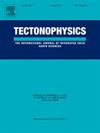粒状岩盒模拟断层运动的能量收支分析
IF 2.7
3区 地球科学
Q2 GEOCHEMISTRY & GEOPHYSICS
引用次数: 0
摘要
在这里,我们提出了能量收支分析,将地震震源机制与地质结构的发展联系起来,在数值颗粒岩箱实验中,利用离散元法模拟方法。该模型在地质尺度(100 km × 0.25 km × 2 km)上模拟了三维细颗粒岩层的水平缩短过程,最大单元半径为12.5 m。这种模拟再现了由产生弹性波的元件的快速和间歇运动引起的毫米级断层位移,即虚拟地震。模拟还捕获了发生在几十秒内的早期地震后过程,在此期间,活动断层之间的弹出结构被抬升。我们在模拟过程中分析了190多个地震事件,总缩短长度为14.72 m。能量平衡的变化始于产生主震的局部断层电位下降,随后是由传播波引起的区域电位释放。统计分析表明,能量变化幅度与断层滑动位移之间存在线性到二次的正相关关系。值得注意的是,在发震断层中,大约0.01% ~ 60%的局部接触电位下降被转化为动能,并且这种转化的效率随着地震规模的增加而增加。我们的研究结果表明,弹出式构造的隆升能量远远超过波能几个数量级,不能仅仅用局部发震断层电位释放来解释。相反,还应考虑断层外区域的潜在释放。给出了地震能量和地震矩的标度规律。我们的研究结果表明,虚拟地震的固有多样性部分地捕捉了地震行为。本文章由计算机程序翻译,如有差异,请以英文原文为准。
Energy budget analysis of fault motion in a granular rock box simulation
Here, we present the energy budget analysis that links seismic focal mechanisms to the development of geological structures in numerical granular rock box experiments, utilizing a discrete element method simulation approach. The model simulates the horizontal shortening of a thin 3D granular rock layer on a geological-scale (100 km 0.25 km 2 km), with a maximum element radius of 12.5 m. This simulation reproduces the millimeter-scale fault displacements caused by the rapid and intermittent motions of elements generating elastic waves, that is, virtual earthquakes. The simulation also captures early postseismic processes occurring within several tens of seconds, during which popup structure between the active faults is uplifted. We analyzed over 190 earthquake events during the simulation, with a total shortening length of 14.72 m. The change in energy balance starts with a local fault potential drop that generates the main shock, followed by a regional potential release induced by propagated waves. Statistical analysis reveals positive correlations, ranging from linear to quadratic, between the magnitudes of energy changes and fault slip displacement. Notably, approximately 0.01 % to 60 % of the local contact potential drop in the seismogenic fault is converted into kinetic wave energy, and the efficiency of this conversion increases with the earthquake size. Our results reveal that the uplift energy of the popup structure, which considerably exceeds the wave energy by several orders of magnitude, cannot be explained solely by the local seismogenic fault potential release. Instead, off-fault regional potential release should also be taken into account. We also demonstrate the scaling law for earthquake energy and seismic moment. Our findings suggest that the inherent diversity of virtual earthquakes partially captures earthquake behaviors.
求助全文
通过发布文献求助,成功后即可免费获取论文全文。
去求助
来源期刊

Tectonophysics
地学-地球化学与地球物理
CiteScore
4.90
自引率
6.90%
发文量
300
审稿时长
6 months
期刊介绍:
The prime focus of Tectonophysics will be high-impact original research and reviews in the fields of kinematics, structure, composition, and dynamics of the solid arth at all scales. Tectonophysics particularly encourages submission of papers based on the integration of a multitude of geophysical, geological, geochemical, geodynamic, and geotectonic methods
 求助内容:
求助内容: 应助结果提醒方式:
应助结果提醒方式:


